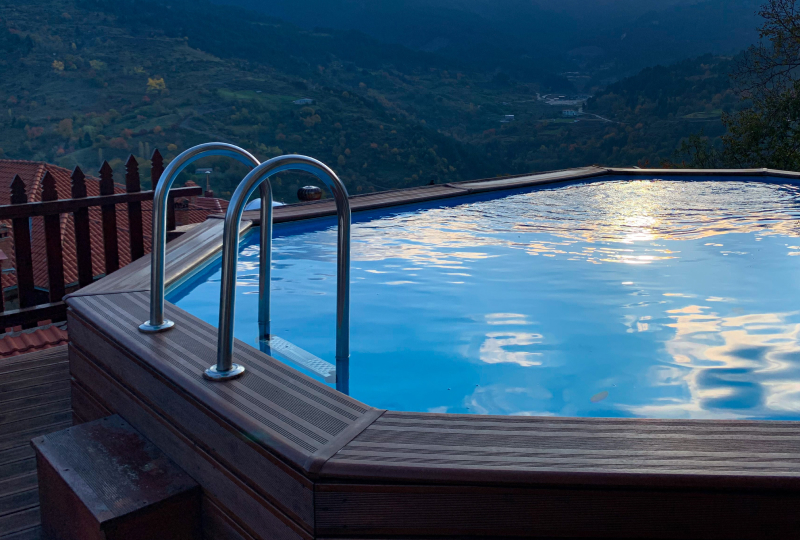
How to Open and Close an Above Ground Pool
Two of the biggest tasks involved with having an above-ground pool are at the season’s start and end. After winter, you’ll need to open your above ground pool properly to enjoy clean, clear pool water all swimming season. You’ll also need to know how to winterize an above ground pool for when the pool season is over.
Jump To Section:
Opening an Above Ground Pool
Preparing to Open an Above Ground Pool
How to Open an Above Ground Pool
Closing an Above Ground Pool
Preparing to Close an Above Ground Pool
How to Close an Above Ground Pool
How to Blow Out Pool Lines
Using Antifreeze in Pool Lines
Opening An Above Ground Pool
Preparing To Open An Above Ground Pool
Gather the following materials and tools before starting the process of opening an above ground pool after winter:
- A friend to help
- Pool cover pump or sump pump
- Soft broom or skimmer net
- Cleaner for winter cover
- Scrub brush
- Pool test kit or test strips
- Pool chemicals
Opening your above ground pool will take most of the day, so choose a suitable day.
How To Open An Above Ground Pool
1. Clear Off Winter Pool Cover
Use a pool cover pump or sump pump to remove any excess water from the pool safety cover or winterized cover. Be patient – this process can take a few hours.
Try to get as much debris off the pool cover as possible using a broom or skimmer net. To prevent damage, use a gentle touch and avoid using anything sharp.
2. Remove Your Winter Pool Cover
With the help of a friend, carefully take off the cover. To make it more manageable, start at one end of the pool to lift the cover, then fold it back onto itself (rather than pulling it to the end). Avoid dragging the cover to prevent excessive debris from entering the pool.
If there’s a pool air pillow, remove it along with your cover. Once it’s out of the pool, deflate the air.
3. Clean Your Winter Pool Cover
Find an open space like the driveway or a large patch of grass to spread the cover flat. Use water, cleaner, and a scrub brush to clean the cover gently.
Allow it to dry completely, then store your winter cover in a durable, tightly sealed storage container.
4. Remove Winter Plug(s) and Skimmer Ice Compensator
Take out all the plugs from the openings, including the return jets and skimmer bucket. If applicable, remove the ice compensator from your skimmer bucket and/or skimmer plate.
Reinstall your skimmer baskets and return jets. Ensure water can easily flow through the skimmer bucket before you’re ready to operate your filter system.
5. Fill Up the Pool
If you need to add water to reach the proper level, use a hose filter to screen out impurities. Add water until your pool reaches the halfway mark of your skimmer’s opening.
6. Prepare and Re-Install Your Equipment
Reinstall all drain plugs and pressure gauges to your filter system, pump, and other pool equipment.
Reattach your system hoses to your equipment by connecting the skimmer to the pump, then the pump to the filter. If you have a heater and chlorinator, connect the hose to this equipment. If not, attach the hose to the return inlet. Recheck all of the connections.
Inspect and wipe down your deck gear, including ladders, rails, diving board, and steps. Put them back in your pool.
If you have a multiport valve, select the filter setting.
7. Turn On Your Pump and Filter
If your pump requires priming, shut off your filter system, remove the pump lid, and add water. Replace the lid before restarting the system.
Turn on your pool system. Monitor your equipment for several minutes to ensure everything is working correctly and that there are no leaks. If the pressure increases quickly, turn off the pump and inspect for blockages.
Clean your filter.
8. Clean Your Pool
Skim your pool to collect any floating debris and brush your pool. Vacuum your pool to remove any debris.
9. Add Start-Up Chemicals
Test your pool water using test strips or a test kit. Balance any chemicals necessary.
Wait 24 hours for the chemicals to do their work.
10. Complete a Shock Treatment
Double shock your above ground pool. Mix two pounds of chlorine shock for every 10,000 gallons of water or 2.5 gallons of liquid shock for every 10,000 gallons of pool water. Complete the shock treatment at night to prevent burning the shock too quickly.
11. Allow Your Pump to Operate
Let your pool pump run for a minimum of 24 hours. Continue vacuuming any debris that appears.
Retest your pool water. If the chemicals are balanced and the pool water is clear, it’s suitable for swimming.

Closing An Above Ground Pool
Preparing To Close An Above Ground Pool
Gather the following materials and tools before starting the process of closing an above ground pool for the winter:
- Winter cover
- Cover clips
- Cover winch and cable
- Water bags (if there’s a walk-around deck)
- Test strips or a water testing kit
- Pool chemicals
- Enzyme supplement
- Expansion and return line plugs
- Pool air pillow
How To Close An Above Ground Pool
1. Clean Your Pool
Vacuum the pool, brush down the walls, and skim the surface to make it easier to open your pool in the spring.
2. Perform a Final Pool Maintenance Routine
Test your pool water using test strips or a water testing kit. Balance your water.
Check for leaks, inspect the liner, and ensure all screws and bolts are tight. Inspect for rust on any metal parts. Perform any maintenance necessary.
3. Add Winterizing Pool Chemicals
Use winterizing chemicals to help prevent damage to your pool liner and other components. Follow the directions on a winterizing chemical kit or manually add any pool chemicals necessary.
4. Complete a Final Shock Treatment
To boost your sanitizer over the winter months, add pool shock. You can either use a fast-dissolving shock or a regular shock product.
To prevent algae from blooming over the winter months, you have the option to add an algaecide to your pool. A clarifying enzyme treatment can help break down organic waste and keep your water clean until the opening season.
5. Clear the Lines
Detach the hoses from your pump and filter, allowing the water to empty. Wait for the lines to fully dry before storing them in a dry place out of direct sunlight.
6. Winterize Your Skimmer
Winterize your skimmer in one of two ways:
- Take out the skimmer basket and place it somewhere safe and dry.
- Cover your skimmer with a plate to seal out the elements.
If you use a winter skimmer plate, you won’t have to drain your pool below the skimmer line. If you don’t, you should monitor the skimmer during the winter to ensure water can continue draining during rainfall.
7. Winterize the Filter and Pump
Pump
Take out all drain plugs, then remove the pool pump, chlorinator (if applicable), and hoses. Store everything indoors to extend their lifespans.
Filter
Winterizing the filter for your above ground pool will depend on the type that you have:
DE: Drain the filter, then rinse off the fingers to remove the remaining DE. Keep the valves open.
Cartridge: Drain the filter, then rinse it thoroughly. Keep the valves open, then store the filter indoors.
Sand: Select the winterize setting on your multiport valve. Take out the drain plug at the bottom. If there’s a bleeder valve and a sight glass, remove them and properly store them away. Bring your filter indoors for storage. If it’s too heavy, you can leave it outside. Be sure to remove all the drain plugs to prevent damage from expansion.
8. Remove Pool Equipment
Take out any pool accessories, including your above ground pool ladder and toys. Clean them thoroughly, then allow them to dry. Store them in a clean, dry place away from direct sunlight.
If you have a saltwater pool, remove your saltwater chlorine generator, drain it, and store it. Turn off all power and gas to your system.
9. Lower the Pool Water (If Applicable)
Drain the water to just below the skimmer and returns. You won’t need to drain your pool if you have a winter skimmer plate.
10. Install a Pool Pillow
Using a pool air pillow (also known as an ice compensator) helps prevent damage to the sides of the cover and walls of your pool. Although it’s not a requirement when winterizing your above ground pool, it provides much more effective protection from ice.
Inflate the pool pillow to approximately 50-60 percent of its capacity. To extend the life of your pool pillow, seal the seams and valves with duct tape after inflating the pillow. Place the pool pillow in the centre of the pool and secure it.
If you don’t use a pool pillow, monitor your pool cover for water and debris buildup. When there’s a large amount, remove it using a cover pump.
11. Install a Winter Cover
Use either a cable and winch or winter cover clips and a cable to secure your cover and air pillow over your pool. Add water bags to help secure your cover if there is a walk-around deck. Over the winter, remove excess water with a pool cover pump to keep your cover in optimal condition.
How To Blow Out Pool Lines
If your above ground pool is hard-plumbed, you’ll need to blow out your pool lines. This is unnecessary if you live in a warm climate.
1. Remove any remaining water from your skimmer after lowering your pool.
2. Open the pump valves.
3. Select the recirculate setting on your multiport valve.
4. Open the drain plug.
5. Attach the air compressor to the pump using an adaptor if necessary.
6. Blow air through the system. Noticeable bubbles will appear out the return lines and skimmers.
7. Place rubber pool plugs into the bottom of the skimmer.
8. Select the main drain setting on your pump valve.
9. Wait a couple of minutes while air bubbles leave from the main drain.
10. Select the skimmer setting on your multiport valve.
11. Turn off your air compressor.
12. Insert a rubber pool plug inside the pump.
Using Antifreeze In Pool Lines
Antifreeze isn’t necessary if you live in a mild climate or have properly blown out your hard-plumbed lines. If you decide to use antifreeze, select a pool antifreeze (not car antifreeze) and follow the manufacturer’s instructions.

